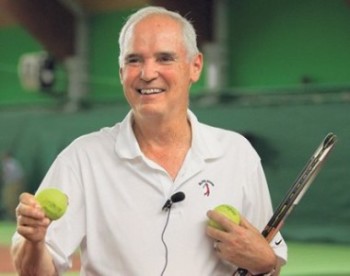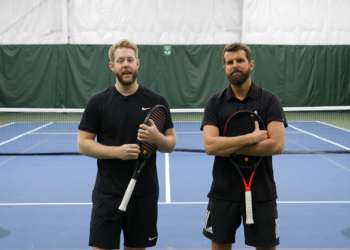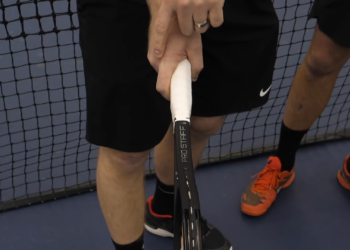
A simple technique to improve your contact point
Hey guys, Nate and Scott here with PlayYourCourt.com and today we’re going to show you a technique that will improve your timing and your contact point. This video is for tennis players with a PlayYourCourt rating of 80 and below. If you’re not in our community and you’re serious about improving your tennis game, you really shhould be. So click the link down below, check it out. Nate and I are going to help you improve your tennis game. Give you the custom stuff that you need but if you’re not already in the community, a PlayYourCourt 80 is the equivalent of about a USTA 4.5. So, Nate, talk to me here, 4.5 and below, that’s a big skill level range that we are talking about here. This must be something huge.
Tim Gallwey’s bounce hit technique
Yeah guys, today we’re going to be talking about Tim Gallwey’s “bounce-hit” technique. I know it’s been around for a long time but we’re going to do is we’re going to demo it.

He basically just was trying to figure out why the curve of learning tennis was so difficult. And he realized the sending and receiving of the sport and the timing is what throws people off. So he came out with this concept, “bounce-hit.” I know many of you have read his book, “The Inner Game of Tennis,” if you haven’t definitely get out there and check it out.
But what we’re really going to do today is demo it. Because we do think a lot of our students when they talk about it, they reference it, they actually kind of have it mixed up. Alright, but so for you guys that don’t know, what Tim really.. The groundbreaking work he did was, if you give simple instructions of bounce, right, as the ball that you’re receiving bounces on the ground. If you time you takeback, so back then, it was, you know low and flush right at the ball. But today, we’re doing more of these unit turns, racket tip up. But if you’re getting this unit turn as you say bounce, it’s going to allow you proper contact, because you’re going to get the racket out to the ball, where a lot of times, we’re unaware that the ball has bounced, and we don’t have our unit turn back.
It’s the point of reference, right? I mean you know you’re supposed to do this stuff but I think a lot of players struggle with when. What’s the order of events? This “bounce-hit” method really clears that up.
Monica Selles and the Contact Point Grunt
So, a cool little story before we hop in. You guys out there, we all know who Monica Seles is right? So if you remember, she was like, the first one that really had the big grunt. And it was what, “Ahh-eee”
So “Ahh-eee”-bounce-hit right? It was just a timing method. Everyone hated it and she actually tried to take her grunt away, and it just wrecked her timing.
Yeah, threw her contact point way off. Just wrecked it, right? We’re not suggesting that you grunt like Monica Seles, we’re just telling you this stuff does work.
100%. So Tim Gallwey, going back to him this “bounce-hit” we’re going to demonstrate it, okay? And we’re going to show you what it looks like. We’ll do this pretty slow right?
And then maybe we’ll speed it up a little bit. But check it out, we’re going to do it right now. So guys, what you’re going to hear is an auditory response of “bounce” when the ball is ready to hit the ground not as it hits but just before. And as I’m saying “bounce” I’ll take my racket back to the unit turn and then “hit” is the racket out to contact. And Scott’s going to do it as well, and see if we can’t get in-sync here with a little bit of rhythm with this technique.
Okay guys, so now we’re going to pick up the pace. You’re going to see that this “bounce-hit” happens much, much faster. But we are still getting these auditory cues in order to prep the racket and get contact out in front.
Alright guys, so not earth-shattering stuff here. This is simple, but it really, really works. If you don’t like “bounce-hit” I know with a lot of my junior students it keeps them entertained, peanut-butter, marsh-mellows, it’s fine whatever you want to say, just two words that get you in a rhythm. This auditory response and just identifying the ball and timing something with your voice is what dials in and really helps you find that rhythm that you’re looking for in your ground strokes.
‘Cause there is a pulse to it, right?
Yeah for sure.
You can feel it right?
For sure, bounce, hit.
So guys, the last thing that I’ll leave you with is if you’re not sure, if you’re not buying into Tim Gallwey and this idea, the Golden State Warriors, when they first won their championship, credited Tim Gallwey and his book, “The Inner Game of Basketball” right? So this guy is obviously, has his finger on the pulse of sports.
For sure, and guys as always even in referring you to a book we’re not getting paid for, we just want to see you improve your tennis game. Nate and I here at PlayYourCourt want to give you the specific instruction that you need, but we need to know a little more about you. So do us a favor, click the button or the link below. Join the PlayYourCourt community where we can send you custom video coaching each week and pair you up with the practice partners that you need to get out on the court and practice this stuff. Click the button or the link below and answer some questions, jump inside the community.
Also, if you liked this video, please press “like”. It’s a hard thing for me to say, it’s like “pre-press” Please press like, if have anything that you want to to see, comment below and make sure you subscribe to our channel to never miss Nate’s beard in action. We’ll see you guys soon.
Click here to get your custom video coaching: http://bit.ly/2ICEOwc



